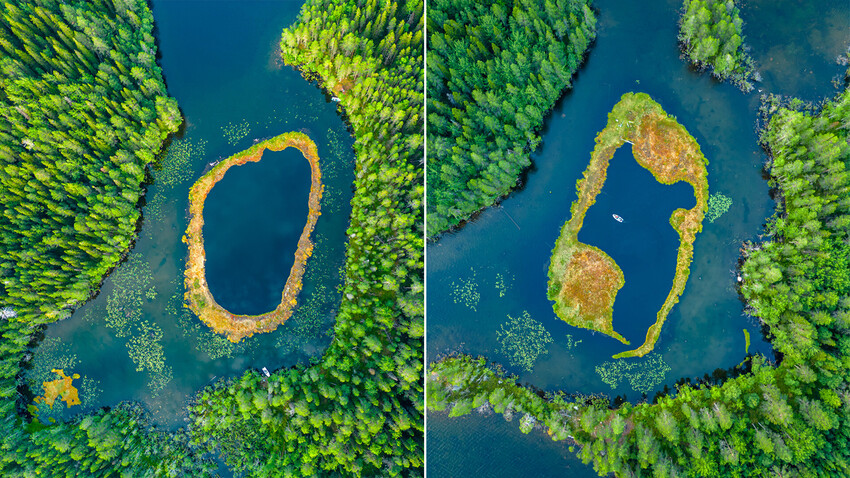
The Solovetsky Islands is an archipelago that is located in the waters of the White Sea, with an area of 347 square kilometers. The traces of human presence here reach 6 millennium B.C. Even today, this place has many mysteries. For a long time, these two lakes – ‘Bublik’ and ‘Kalach’ – were one such mystery.
The Solovetsky Archipelago includes six large islands – Solovetsky, Anzersky, Bolshaya Muksalma, Malaya Muksalma, Bolshoy Zayatsky and Maly Zayatsky – and about a hundred smaller islands. This is the territory of the Far North and the average summer temperature in these parts is just +11 degrees Celsius, with it reaching -30 degrees during winter.
The Solovetsky stavropegial monastery and the Solovetsky labyrinths are the most famous spots around. Under the Soviets, the territory of the monastery hosted a labor camp; 200,000 prisoners went through it (every third was executed by shooting squad). The stone labyrinths of Bolshoy Zayatsky Island are one of the largest such labyrinths in the north of Europe.
But there are also other “attractions”, less popular, due to their inaccessibility. Such as Kalach and Bublik lakes.
Kalach and Bublik are lakes that are literally “floating” inside another lake named Bolshoye Krasnoye Lake. They are located on Solovetsky Island and are noteworthy, first of all, for the fact that these bodies of water are surrounded by strips of swampy land and are practically considered separate lakes. You can even walk these tiny islands around ‘Kalach’ and ‘Bublik’ (but, only with great caution, as one risks falling through into the water).
These ‘floating islands’ (this is what this phenomenon is called) appear, due to strong winds that tear off plants from the shores of lakes and sweep them into a compact mass right on the water. Sometimes, pond scum, peat and algae from the bottom can also get into the mix. Meanwhile, the air in the roots of the plants doesn’t let it sink. With time, this mass begins to grow and spread; it can reach a thickness of several meters and a surface area – if the terrain allows it – of up to several hectares.
Despite the fact that these floating islands are not a unique phenomenon, Kalach and Bublik still stand out: their shores didn’t simply become a thick plant mass, but formed rings, inside of which, as it turned out, two more lakes formed.
You can reach the Solovetsky Islands by plane from Arkhangelsk; you have to book your tickets a minimum of two weeks in advance, so you have to plan your trip in advance.
To reach Bolshoye Krasnoye Lake, where Kalach and Bublik “float”, you have to delve quite deep into uninhabited lands – northwest from the city of Solovetsky. It’s best to find someone who can safely guide you to the place.
By the way, Kalach and Bublik are located on different ends of the lake, so for a comfortable journey it’s probably better to choose just one (Bublik is slightly closer to the city of Solovetsky).
If using any of Russia Beyond's content, partly or in full, always provide an active hyperlink to the original material.
Subscribe
to our newsletter!
Get the week's best stories straight to your inbox